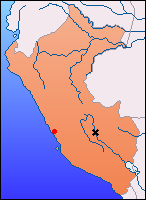 |
Related pages: |
Aguas Calientes, also known as Machu Picchu Pueblo, is a small town located in the Sacred Valley of the Incas, in the Cusco region of Peru. Nestled at the base of the mountain that hosts the historic sanctuary of Machu Picchu, Aguas Calientes is the final stop for visitors eager to explore one of the seven wonders of the modern world. With its lush natural surroundings, hot springs, and a growing cultural and touristic offer, Aguas Calientes is much more than a mere transit point to Machu Picchu.
Due to its geographic location, Aguas Calientes is not accessible by road. Most visitors opt to take the train from Cusco, Ollantaytambo, or Poroy, which offers spectacular views of the Sacred Valley's nature. Railway companies like PeruRail and Inca Rail offer various services, ranging from economy options to luxury experiences.
For the more adventurous, it is possible to arrive on foot via the “Hydroelectric Alternative Route.” This involves a vehicle ride to the hydroelectric station, followed by a roughly two-and-a-half-hour walk along the train tracks. This alternative is popular among backpackers and those who seek a more immersive and budget-friendly experience.
The hot springs that give the town its name are one of Aguas Calientes' main attractions. Located just minutes from the town center, these natural pools offer mineral-rich waters with medicinal and relaxing properties. Visitors can enjoy a warm bath surrounded by greenery and mountains, perfect for unwinding after a day of exploring Machu Picchu.
The springs are open daily with an affordable entrance fee. It is recommended to bring swimwear and a towel, along with some cash for the entry fee and any additional expenses like locker rentals.
The Aguas Calientes craft market is the perfect place to find unique souvenirs of Andean culture. Located near the train station, the market offers a wide variety of handcrafted items, such as textiles, ceramics, silver jewelry, and alpaca products. It’s a great opportunity to support local artisans and bring a piece of Peru back home.
You can also find typical products like coca leaves, which are popular among tourists for alleviating altitude sickness. Prices are usually negotiable, making it an excellent opportunity to practice bargaining.
Another must-see natural attraction is the Mandor Botanical Garden, located about an hour’s walk from the town center. This conservation area is home to a wide variety of exotic plants, flowers, and bird species. Highlights of the garden include a beautiful waterfall and vegetation that showcases the region’s diverse flora.
The Mandor Garden is ideal for those seeking a closer connection with nature, away from the crowded tourist spots. The entrance fee is modest, and the walk offers a unique chance to enjoy the local biodiversity in a peaceful setting.
For those interested in history and archaeology, the Manuel Chávez Ballón Museum is a must-visit. Located about a 30-minute walk from the town center, this museum provides an in-depth look at the archaeological discoveries of Machu Picchu, as well as insights into the daily life of ancient Inca inhabitants.
The museum displays a collection of artifacts including tools, ceramics, and metal objects that help visitors better understand the historical context of Machu Picchu. The entrance fee is affordable and allows guests to immerse themselves in the rich history of the region before or after their visit to the Inca sanctuary.
Aguas Calientes offers a wide gastronomic selection to suit all tastes and budgets. From luxury restaurants to small street food stalls, the town provides a variety of Peruvian and international dishes. Must-try dishes include ceviche, lomo saltado, and ají de gallina, as well as Andean specialties like roast guinea pig and fresh trout from the region’s rivers.
Many restaurants also offer vegetarian and vegan options, and some use organic ingredients grown in the area, perfect for those seeking a more authentic and sustainable culinary experience.
For travelers seeking a physical challenge, it is possible to hike to Machu Picchu from Aguas Calientes. The hike takes about 1.5 to 2 hours and consists of a series of steep stairs leading to the entrance of the sanctuary. Although physically demanding, the hike offers breathtaking views and allows visitors to enjoy the jungle scenery surrounding the archaeological site.
It is advisable to start the hike early in the morning to avoid the heat of the day and bring plenty of water, sun protection, and insect repellent, as the trail passes through jungle areas where humidity and mosquitoes can be intense.
The climate in Aguas Calientes is typically warm and humid due to its location on the edge of the jungle. The rainy season lasts from November to March, and during these months, intense rains can affect access to Machu Picchu. The dry season, from April to October, is the ideal time to visit, as rains are less frequent and temperatures are pleasant.
Regardless of the time of year, it is recommended to bring light but waterproof clothing, as well as layers to adapt to the temperature changes common in the Andean region.
Aguas Calientes is much more than a stop on the way to Machu Picchu. This picturesque town offers a variety of cultural, natural, and adventure experiences that perfectly complement a visit to the famous Inca citadel. Whether relaxing in the hot springs, exploring the Mandor Gardens, or sampling the delicious local cuisine, Aguas Calientes allows visitors to immerse themselves in Peru’s culture and natural beauty.